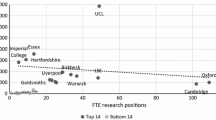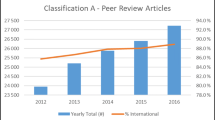Abstract
Year-on-year trends in research outputs show increases in research activity as the date of the research assessment exercise—in New Zealand the Performance-Based Research Fund (PBRF)—looms. Moreover, changes with time in the number and types of conference presentation indicate that the vehicle of publication is also being influenced by the PBRF. Within New Zealand business schools, relating the published journal articles to the Australian Business Deans Council rankings list shows a trend towards more publications of lower rank, raising doubts about whether the rhetoric about the PBRF raising the quality of research is really justified. This ‘drive’ towards increasing numbers of research outputs is also fostered by an increasing trend towards co-authorship in publishing across all disciplines.









Similar content being viewed by others
References
Adams, J. (2008). The future of the British RAE: the REF (Research Excellence Framework). Forum on “Measuring Research Performance: What are the Options?” Wellington, 18 September 2008.
Anderson, D. L., & Tressler, J. (2008). Research output in New Zealand economics departments 2000–2006: A stock approach. New Zealand Economic Papers, 42(2), 155–189.
Australian Business Deans Council. (2008). Combined journal lists. Retrieved September 7, 2009, from http://www.abdc.edu.au/download.php?id=1373084,192,1.
Barker, K. (2007). The UK Research Assessment Exercise: The evolution of a national research evaluation system. Research Evaluation, 16(1), 3–12.
Butler, L. (2006). Methodology for citation analysis. RQF pilot study project—History and political science, Council for the Humanities, Arts and Social Sciences. Retrieved June 29, 2009, from http://www.chass.org.au/papers/PAP20061102LB.php.
Clark, J. (2009, April). Bibliometrics Conference Report [Report on the National and Institutional Perspectives on Metrics-based Research Evaluation Conference, Brisbane, Australia]. Retrieved August 10, 2009, from www.library.otago.ac.nz/pdf/BibliometricseventBrisbane_2_.pdf.
Corbyn, Z. (2008). RAE results may not reflect true quality of UK research, warns chair. Times Higher Education, 4 December 2008. Retrieved October 27, 2009, from http://www.timeshighereducation.co.uk/story.asp?sectioncode=26&storycode=404590.
Doyle, J. R., & Arthurs, A. J. (2000). Judging the quality of research in business schools: The UK as a case study. Omega, 23(3), 257–270.
EFMD. (2009). EQUIS [European Quality Improvement System] standards and criteria (p. 46). Brussels, Belgium: European Foundation for Management Development.
Garfield, E. (1972). Citation analysis as a tool in journal analysis. Science, 178, 471–479.
Moed, H. F. (2008). UK Research Assessment Exercises: Informed judgements on research quality or quantity? Scientometrics, 74(1), 153–161.
Piercy, N. (2000). Why it is fundamentally stupid for a business school to try and improve its research assessment exercise score. European Journal of Marketing, 34(1/2), 27–35.
Smart, W. (2007). Quality vs impact: A comparison of performance-based research fund quality scores with citations. Retrieved August 10, 2009, from http://www.educationcounts.govt.nz/publications/tertiary_education/11766.
Smart, W. (2009, April). The use of bibliometrics to measure the performance of New Zealand’s tertiary education system. Paper presented at the National and Institutional Perspectives on Metrics Based Research Evaluation, Biometrics Conference, Brisbane, Australia.
Smith, A. G. (2008). Benchmarking Google Scholar with the New Zealand PBRF research assessment exercise. Scientometrics, 74(2), 309–316.
Staff and Student Research. (2000–2007). Wellington: Victoria University of Wellington.
Taylor, H., & Dillon, S. (2007). The changing face of IS research—A longitudinal citation study of author influence. Research Report Series, Department of Management Systems, University of Waikato, 2007-05.
Tertiary Education Commission. (2004). Performance-based research fund evaluating research excellence: The 2003 assessment (p. 278). Wellington: Tertiary Education Commission.
Tertiary Education Commission. (2007). Performance-based research fund evaluating research excellence: The 2006 assessment (p. 314). Wellington: Tertiary Education Commission.
Author information
Authors and Affiliations
Corresponding author
Rights and permissions
About this article
Cite this article
Hodder, A.P.W., Hodder, C. Research culture and New Zealand’s performance-based research fund: some insights from bibliographic compilations of research outputs. Scientometrics 84, 887–901 (2010). https://doi.org/10.1007/s11192-010-0201-0
Received:
Published:
Issue Date:
DOI: https://doi.org/10.1007/s11192-010-0201-0




